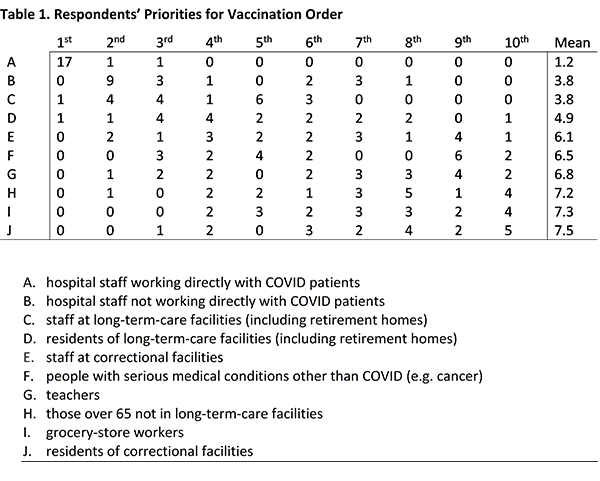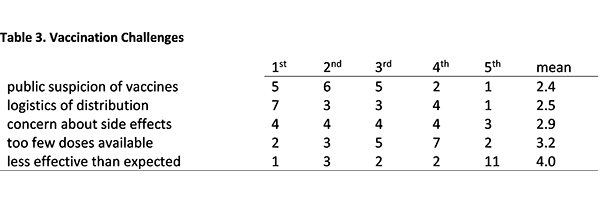
Since May, as one component of the IGPA Pandemic Stress Indicators, a panel of three sets of experts have periodically shared their opinions about pandemic policies. Specialists on economics, public health, and/or vulnerable populations from across Illinois have generously agreed to provide regular perspectives on various pandemic policies. In answering the surveys, all panelists provide only their personal views and do not offer official positions on behalf of their respective institutions.
The 10th wave of the Pandemic Stress Indicator Expert panel survey was launched on Dec. 2, and we received 19 responses. The focus of this final consultation of 2020 concerned, in large part, COVID-19 vaccines and plans to implement a comprehensive vaccination program.
Respondents were asked how they would prioritize the distribution of vaccine doses at this early stage, while scarcity and logistical challenges of distributing the vaccine loom large. We asked who should determine the priority sequence for vaccination, offering five response options (the president, the Centers for Disease Control and Prevention “(CDC”), governors, local officials, hospital and clinics) plus “other.” Nearly every respondent chose the CDC, with only one preferring sub-national decentralization of the decision (“governors”) and one selecting “the FDA—the entity actually doing it”. [1]
We next sought our respondents’ views about who should receive the vaccine first, by listing 10 groups (randomly ordered) and asking for rankings, from 1 (highest priority) to 10 (lowest). Table 1 reveals near consensus that those first in line should be hospital employees working directly with COVID-19 patients. The next highest rankings, in a near tie, were hospital workers not directly in contact with COVID-19 patients and employees at long-term-care facilities. Congregate care facilities have been hot spots for COVID-19 spread throughout the U.S., so it is probably not surprising that residents of long-term care facilities came next.
Respondents exhibited less agreement on the remaining groups, as the relatively close clustering of means over the fifth through 10th items in Table 1 reveals.
A different dimension of priority is how available vaccine doses will be distributed across and within states. In regard to the latter, we asked, “Within Illinois, do you expect that the procedure for allocating vaccine doses across regions/counties will be fully transparent?” Respondents were quite evenly divided and unsure: five said yes, four no, and 10 opted for maybe or not sure.

As a follow up, we asked what factors should determine how vaccine doses get distributed within Illinois. Rather than asking for rankings, or just one criterion, we allowed respondents to select as many of the options shown in Table 2 as they liked. As Table 2 reveals, most respondents chose more than one factor. Only one respondent thought that apportionment should follow population alone, and only one thought it should be set according to the current COVID-19 caseload alone. The most popular answer proved not to be the overall populations, but, rather, vulnerable populations, in terms of demographics and in terms of health histories.

We also asked for a ranking, from most worrying to least worrying, of five “difficulties or challenges in implementing a COVID-19 vaccination program.” Table 3 indicates that public suspicion of vaccines and vaccination was the most popular top choice, with logistics close behind. An unexpectedly ineffective vaccine was the lowest ranked item, with worries about side effects from the new COVID-19 vaccines and scarcity falling in between.

For one final perspective on the vaccination challenge, we queried respondents about which of a small set of items they regard as the biggest challenge for President-elect Joe Biden’s incoming administration. This question pitted implementing a vaccination program against surging COVID-19 cases and other alternatives, including the option of specifying an “other” choice.

Table 4 shows that the pandemic loomed largest for most of our respondents. Notwithstanding the recent assassination of an Iranian nuclear scientist associated with that country’s nuclear-weapons program, no one selected the threat-of-war option. [2] Neither did any respondent see the economy as the main worry. [3] The only dissenters from the COVID-19-related responses were two respondents who thought that lingering belief that the election was rigged would hamper the new president. There was also one respondent who made a prediction that if Republicans retain control of the U.S. Senate, following Georgia’s two runoff elections in early January, President Biden will fall prey to Republican “obstructionism.”
This wave of the survey also featured two open-ended questions. Looking much farther ahead than the change of presidents, we asked what Illinois should be doing now to be ready for the next school year, in the autumn of 2021. Some answers emphasized funding and/or publicizing (even more) simple measures and already familiar protocols (e.g. wearing masks, physical distancing, and separation). Most responses, however, either explicitly or implicitly involved more expenses, and hence new funding.
Others stressed more nuance in how we mitigate risk, such as prioritizing in-person schooling for the youngest and targeting funding toward facilities where online education is least possible. Some process-oriented responses proposed careful but rapid study of what measures have worked best outside of the U.S., and/or in the fairly extensive experimentation undertaken as American jurisdictions have dramatically varied their approach to education through spring of 2019-20 and 2020-21. Other answers, in keeping with findings above, emphasized immediate experimentation to “identify most effective public information messages regarding vaccination efficacy.”
Multiple respondents stressed mandatory vaccination of (in-person) students and teachers, plus some variety of emergency measures to increase teacher supply, including relaxed or accelerated accreditation, and incentives for retired teachers to return to work in some manner. A related theme was that class sizes will have to be smaller, which may necessitate both more teachers and further online-only instruction.
Several ideas regarding infrastructure were proposed, including improvements to ventilation and HVAC systems, and more creative use of outdoor space. Others stressed adjustments used in many commercial settings, such as more barriers, freely available masks, and modifications of structures. All of these changes would likely require some new funding.
A few respondents stressed that vaccination alone is not sufficient to return to pre-pandemic “normal” school, given uncertainty about immunity. In turn, some respondents proposed contingency plans, including a “worst case,” where in-person schooling cannot happen on a large scale.
The final question noted that COVID-19 has proven far, far more fatal for those over 65 than it has for those under 20. In turn, we asked if news media have under-emphasized this contrast, and, separately, if there are any changes in policy warranted. Respondents were divided. Some agreed that media coverage has provided a poor sense of comparative risks faced by the young and old. Others said that they thought media discussions of deaths from the disease have, by and large, been accurate. On the whole, respondents were slightly more skeptical than friendly to the suggestion that news media coverage has hampered public understanding of relative risk.
On the policy side, some respondents noted that there is no gain in stressing morbidity, because death is not the only important metric, and there is still uncertainty about long-term effects from contracting COVID-19. Those opposed to changes in policy noted that because the young can be carriers of the disease, with or without symptoms, their low death rates do not suggest that fewer restrictions, or more conditional restrictions, are warranted. A few responses noted that President Donald Trump’s administration has obscured differences in vulnerability as much as the news media.
For those who concurred that the quite different fates of the very young and very old in the pandemic deserve more attention, school was the top issue. A few respondents stressed the importance of getting primary education back to normal more quickly, given the potential for huge long-term damage to be done by prolonged, ineffective substitutes.
Appendix. Precise Question Wording
W10.Q1. How would you order who should get access to a vaccine first? (highest priority first, lowest priority last) [groups listed in text]
W10.Q2. Who should be responsible for setting the priority sequence for COVID19 vaccination?
the president; the CDC; governors; local officials; hospitals and clinics; other [ ]
W10.Q3. Within Illinois, do you expect that the procedure for allocating vaccine doses across regions/counties will be fully transparent?
Yes; maybe; no; not sure
W10.Q4. How many of the following should be taken into account in distributing available vaccine doses among the regions of Illinois? Please choose as many responses as you wish (unranked).
cumulative COVID deaths to date
present COVID caseload
population
vulnerable populations in terms of demographics (e.g. age, race)
vulnerable populations in terms of medical histories
W10.Q5. Please rank, from most worrying to least worrying, the following difficulties or challenges in implementing a COVID19 vaccination program.
public suspicion of vaccines and vaccination
logistics of distribution
public concern about unknown side effects for these new vaccines
too few doses available in the US
lower than expected effectiveness of the vaccine(s) at preventing infection
W10. Q6. It is presently unclear how many Illinoisans will be vaccinated by late August 2021. What should Illinois do between now and then to be ready for the beginning of the 2021-22 school year?
W10. Q7. Even through the large surge in COVID cases over recent months, the very different outcomes according to age seem broadly unchanged. The elderly (60 and over) constitute about 20 percent of the Illinois population and about 20 percent of the COVID caseload, but that age group has sustained about 90 percent of the COVID deaths. Of the more than 12,000 deaths in the state, only 8 victims have been under 20 years old. Has the media, with its repetition of total-deaths statistics, under-emphasized this contrast? Are there any changes in public policy that would make sense given that fatal cases of COVID are so likely to occur in the elderly while minors almost never die from the disease?
W10.Q8. Which will be the single biggest challenge facing the Biden administration after inauguration?
implementing a vaccination program
a post-holiday surge in COVID cases (on top of the post-Thanksgiving surge)
the faltering economy
prospects of war with Iran
widespread belief that the presidential election was rigged, prompting a new "resistance"
other [ ]
Endnotes
[1] The Food and Drug Administration has authority to approve of vaccines, but the CDC’s independent Advisory Committee on Immunization Practices (ACIP) separately issues recommendations for priorities in the event of shortage. Most expect that public officials will closely adhere to these recommendations, but there is fairly little precedent for such huge demand for a vaccine, outstripping supply.
[2] See, e.g., Bazzi, Mohammad,“The Assassination of an Iranian Scientist Will Make Joe Biden’s Job Harder,” The Guardian, Dec. 7, 2020, accessed Dec. 8, 2020, https://perma.cc/NW9P-D5VY.
[3] On the economy, see, e.g., Pickert, Reade, et al., “Surging Virus Cases, Thanksgiving Holiday, Muddle U.S. Recovery,” Bloomberg, Dec. 7, 2020, accessed Dec. 8, 2020, https://perma.cc/PJ6A-24GD.
Within Illinois, do you expect that the procedure for allocating vaccine doses across regions/counties will be fully transparent?